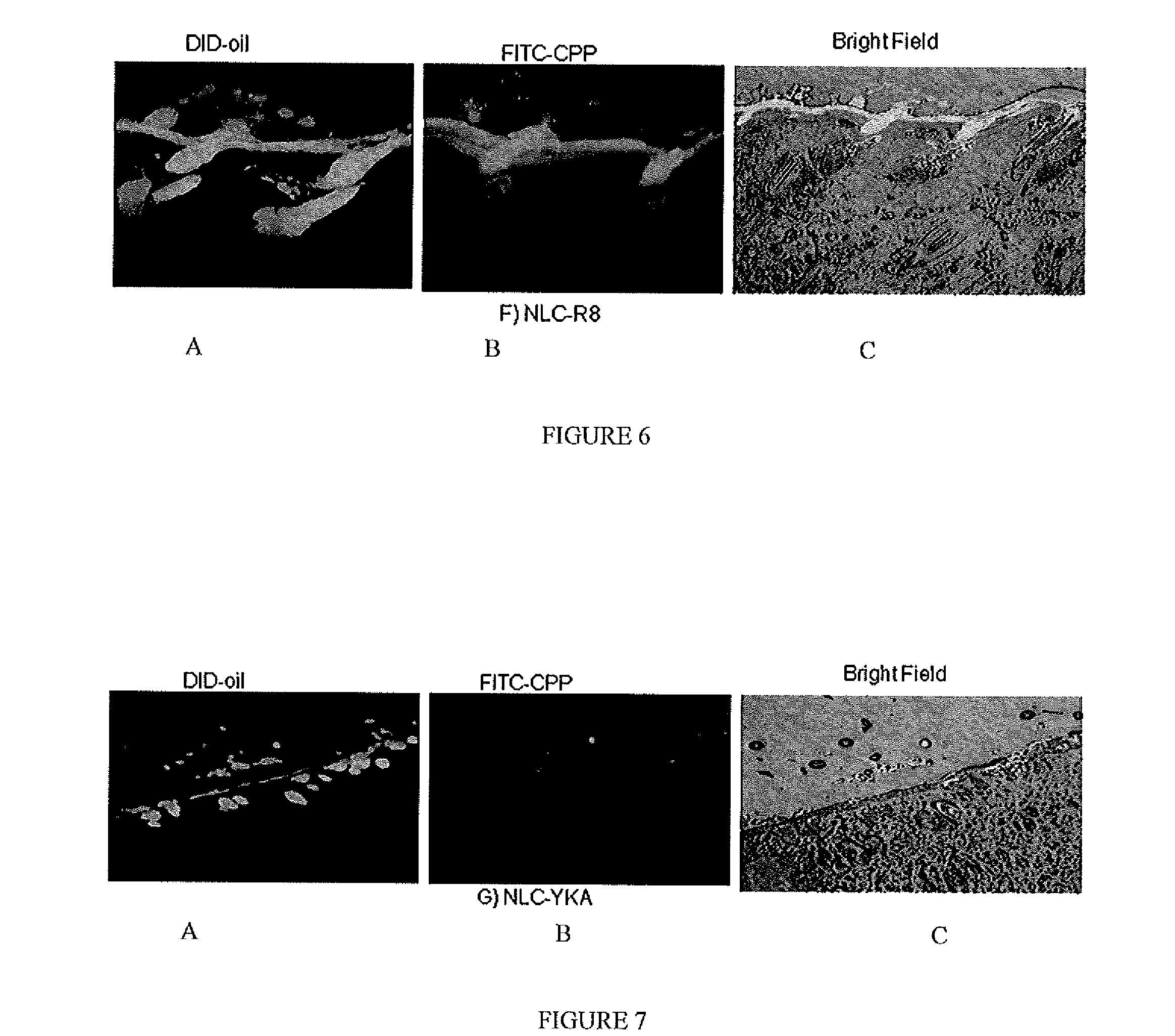Nanoparticle formulations for skin delivery
a technology of nanoparticles and formulations, applied in the direction of drug compositions, biocides, antibacterial agents, etc., can solve the problems of toxicity and therapeutic feasibility of techniques, and the inability of drug candidates alone to achieve the desired therapeutic effect,
- Summary
- Abstract
- Description
- Claims
- Application Information
AI Technical Summary
Benefits of technology
Problems solved by technology
Method used
Image
Examples
example 1
Preparation of Nanoparticles Encapsulating Fluorescent Dye
[0066]Step 1: General Method of Preparing Nanoparticles:
[0067]For tracking nanoparticles in the skin two types of fluorescent dyes were used, DID-oil (Excitation / Emission: 644-665 nm) or DIO dye (Excitation / Emission: 484-501 nm); both dyes are lipophilic. Fluorescent dye encapsulated formulations were prepared by hot melt homogenization technique as described in C. Puglia, et al., Lipid Nanoparticles for Prolonged Topical Delivery An In-Vitro and In-Vivo Investigation, Int. J. Pharma., 357 (2008) 295-304. In brief, fluorescent dye was dissolved in dichloromethane (0.5 ml) and mixed with the lipid phase comprised of Compritol 888 ATO, DOGS-NTA-Ni and Miglyol 812. The organic phase was removed on a rota evaporator for 2-3 hours at 80° C. To the heated lipid phase 20 ml of an aqueous solution containing Tween 80, a surfactant, was added at the same temperature under high speed mixing (20,000 rpm for 1 minute). The resultant oil-...
example 2
Visualization of Fluorescent Labeled Nanoparticles Skin Permeation Using Confocal Microscopy
[0071]The fluorescent dye encapsulated, NLC-DID or NLC-DIO, nanoparticles were prepared according to Example 1 based on the formulation provided in Table 2. The particle size and zeta potential were measured with Brookhaven Instrument (USA). The particle size of the nanoparticles was found to be 173 nm and zeta potential was −11.7 mV; the addition of DID-oil and DIO dye did not change the zeta potential. The particle size range of the nanoparticle formulation in all batches was in the range of 160±20 mm
[0072]In Vitro Skin Permeation and Distribution Analysis:
[0073]Hairless rats (CD® (SD) HrBi, Male) were sacrificed by an overdose of halothane anesthesia and the skin from the dorsal surface was excised and the adherent fat and subcutaneous tissue were removed. The full thickness skin was mounted between the donor and receptor compartments of the Franz diffusion cells (Permegear Inc., Riegelsvi...
example 3
Celecoxib Encapsulated NLC Formulations and Surface Modification for Skin Permeation
[0075]Celecoxib encapsulated nanoparticles (CXB-NLC) were prepared in accordance with Example 1, however the fluorescent dye was replaced with celecoxib (CXB). The composition of the formulation is provided in Table 3. For comparison, CXB solution formulation was prepared by dissolving 5 mg of CXB in 1 ml of ethanol and the volume was made to 10 ml with polyethylene glycol 400 (PEG400), because CXB is lipophilic and insoluble in water.
[0076]
TABLE 3CXB-NLC FormulationIngredientsQuantity (milligrams)Celecoxib20Compritol 888700Miglyol 812300DOGS-NTA-Ni2Tween 80480Distilled water up to25 ml
[0077]The encapsulated CXB-NLC nanoparticle formulation was modified with CPP as described in Example 1, and skin permeation studies were carried out for 24 hours by placing 200 μl of formulations (≈100 μg of CXB) on the donor compartment. The receptor fluid selected was 0.1% w / v Volpo 20 in pH 7.4 PBS, where the satur...
PUM
| Property | Measurement | Unit |
|---|---|---|
| depth | aaaaa | aaaaa |
| size | aaaaa | aaaaa |
| size | aaaaa | aaaaa |
Abstract
Description
Claims
Application Information
 Login to View More
Login to View More - R&D
- Intellectual Property
- Life Sciences
- Materials
- Tech Scout
- Unparalleled Data Quality
- Higher Quality Content
- 60% Fewer Hallucinations
Browse by: Latest US Patents, China's latest patents, Technical Efficacy Thesaurus, Application Domain, Technology Topic, Popular Technical Reports.
© 2025 PatSnap. All rights reserved.Legal|Privacy policy|Modern Slavery Act Transparency Statement|Sitemap|About US| Contact US: help@patsnap.com



